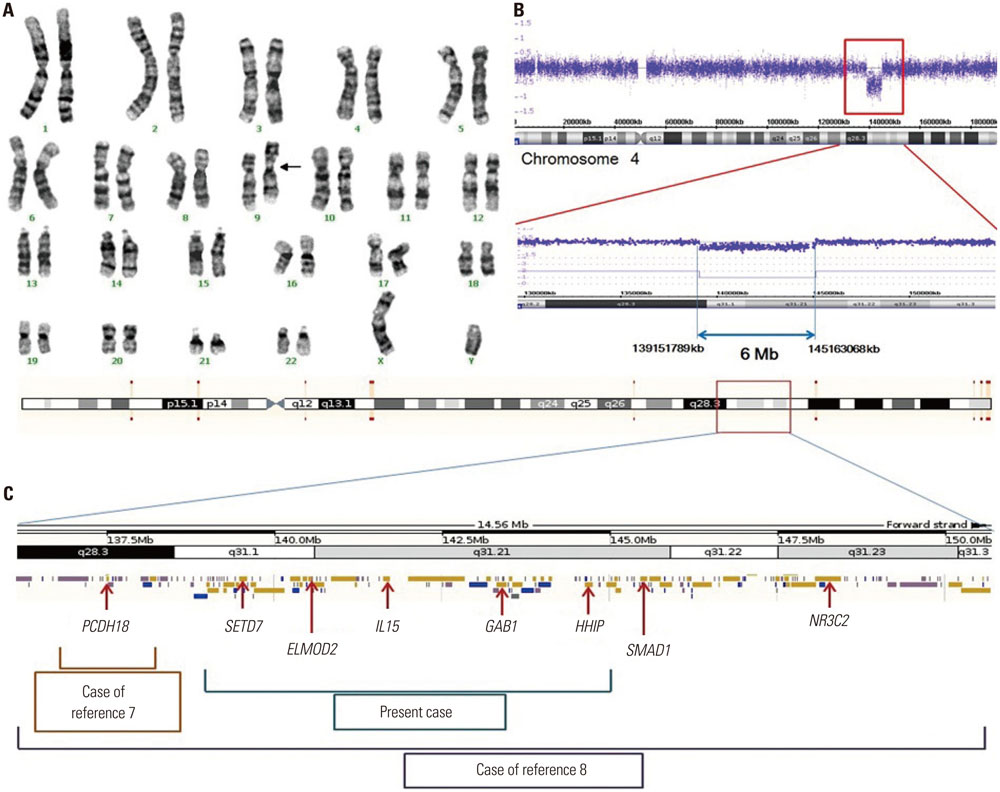Yonsei Med J.
2015 Nov;56(6):1742-1744. 10.3349/ymj.2015.56.6.1742.
Clinical and Molecular Delineation of a Novel De Novo 4q28.3-31.21 Interstitial Deletion in a Patient with Developmental Delay
- Affiliations
-
- 1Department of Laboratory Medicine, Severance Hospital, Yonsei University College of Medicine, Seoul, Korea. jhyooken@gmail.com
- 2Department of Rehabilitation Medicine, National Health Insurance Service Ilsan Hospital, Goyang, Korea.
- 3Department of Laboratory Medicine, Seoul Clinical Laboratories, Yongin, Korea. hansungh@scllab.co.kr
- 4Department of Laboratory Medicine, BioCore, Yongin, Korea.
- 5Department of Laboratory Medicine, National Health Insurance Service Ilsan Hospital, Goyang, Korea.
- KMID: 2345909
- DOI: http://doi.org/10.3349/ymj.2015.56.6.1742
Abstract
- No abstract available.
MeSH Terms
Figure
Reference
-
1. Strehle EM, Bantock HM. The phenotype of patients with 4q-syndrome. Genet Couns. 2003; 14:195–205.2. Strehle EM, Yu L, Rosenfeld JA, Donkervoort S, Zhou Y, Chen TJ, et al. Genotype-phenotype analysis of 4q deletion syndrome: proposal of a critical region. Am J Med Genet A. 2012; 158A:2139–2151.
Article3. Edelmann L, Hirschhorn K. Clinical utility of array CGH for the detection of chromosomal imbalances associated with mental retardation and multiple congenital anomalies. Ann N Y Acad Sci. 2009; 1151:157–166.
Article4. Hsu LY, Benn PA, Tannenbaum HL, Perlis TE, Carlson AD. Chromosomal polymorphisms of 1, 9, 16, and Y in 4 major ethnic groups: a large prenatal study. Am J Med Genet. 1987; 26:95–101.
Article5. Xu W, Ahmad A, Dagenais S, Iyer RK, Innis JW. Chromosome 4q deletion syndrome: narrowing the cardiovascular critical region to 4q32.2-q34.3. Am J Med Genet A. 2012; 158A:635–640.
Article6. Vlaikou AM, Manolakos E, Noutsopoulos D, Markopoulos G, Liehr T, Vetro A, et al. An interstitial 4q31.21q31.22 microdeletion associated with developmental delay: case report and literature review. Cytogenet Genome Res. 2014; 142:227–238.
Article7. Kasnauskiene J, Ciuladaite Z, Preiksaitiene E, Matulevičienė A, Alexandrou A, Koumbaris G, et al. A single gene deletion on 4q28.3: PCDH18--a new candidate gene for intellectual disability? Eur J Med Genet. 2012; 55:274–277.
Article8. Duga B, Czako M, Komlosi K, Hadzsiev K, Torok K, Sumegi K, et al. Deletion of 4q28.3-31.23 in the background of multiple malformations with pulmonary hypertension. Mol Cytogenet. 2014; 7:36.
Article9. Kang MN, Lim IS, Kim BE, Chey MJ, Kim SW. A case of 4q deletion with partial agenesis of corpus callosum. J Korean Pediatr Soc. 2002; 45:273–277.
- Full Text Links
- Actions
-
Cited
- CITED
-
- Close
- Share
- Similar articles
-
- De novo interstitial deletion of 15q22q23 with global developmental delay and hypotonia: the first Korean case
- Interstitial deletion of 5q33.3q35.1 in a boy with severe mental retardation
- A Case of de novo Interstitial Deletion of 17 Chromosome
- Patient With Delayed Development Resulting From De Novo Duplication of 7q36.1-q36.3 and Deletion of 9p24.3
- A Rare Case of a de novo Proximal Deletion of 13q in a Neonate with Congenital Megacolon


